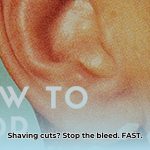A shaving nick can be a frustrating interruption to your morning routine. This guide provides clear, step-by-step instructions and quick solutions to stop the bleeding swiftly and safely.
Stop the Bleeding: A Step-by-Step Approach
1. Apply Direct Pressure
What to do: Grab a clean cloth, tissue, or even a clean fingertip. Press firmly directly on the cut.
How long: Hold for 5-10 minutes without peeking. Lifting the cloth can disrupt clot formation.
Why it works: Direct pressure slows blood flow and encourages clotting.
2. Cool It Down
What to do: After applying pressure, rinse the cut with cool water. Then, apply a cold compress (ice wrapped in a cloth or a cold pack) for a few minutes.
Why it works: Cold constricts blood vessels, reducing blood flow.
3. Seal and Protect (If Needed)
What to do: Once bleeding stops, apply a thin layer of petroleum jelly or lip balm.
Why it works: This creates a protective barrier and helps promote healing. This step is likely sufficient for small nicks, though ongoing research suggests that additional remedies may accelerate the healing process.
Quick Fixes for Shaving Cuts: At-a-Glance
| Method | When to Use It | What to Do |
|---|---|---|
| Direct Pressure | Always the first step | Apply firm pressure for 5-10 minutes. |
| Cold Compress | After direct pressure | Apply for a few minutes. |
| Styptic Pencil/Alum Block | Persistent bleeding | Wet the tip and gently apply to the cut. |
| Petroleum Jelly/Lip Balm | To seal and protect | Apply a thin layer after bleeding stops. |
Advanced Techniques & Home Remedies
Using a Styptic Pencil: A Detailed Guide
- Rinse: Clean the cut with cool water.
- Prepare: Wet the tip of the styptic pencil.
- Apply: Gently touch the tip to the bleeding area for a few seconds. Avoid pressing too hard.
- Rinse Again: Rinse the area to remove residue.
Some studies indicate styptic pencils may possess additional antiseptic properties, though more research is necessary to confirm this. There is debate about the potential for minor tissue damage or irritation, so use with caution.
Other Household Remedies: Proceed with Care
While some people use aftershave (alcohol-based), antiperspirant (with aluminum chloride), or witch hazel for their astringent properties, these can irritate sensitive skin. Use cautiously and discontinue if irritation occurs. Research is ongoing to fully understand the effectiveness and long-term implications of these home remedies.
Understanding Shaving Cuts: Why They Happen
Shaving cuts occur when the razor blade removes a thin layer of skin along with hair, exposing underlying blood vessels. Several factors can make you more susceptible:
- Dull Blades: A dull blade tugs and pulls, increasing the risk of cuts.
- Pressure and Technique: Pressing too hard or shaving against the grain can cause nicks.
- Dry Shaving: Shaving without lubrication increases friction and the likelihood of cuts.
- Skin Type: Sensitive skin is more prone to irritation and cuts.
- Location: Skin thickness and blood vessel concentration vary across the body. Facial skin, being thinner and more vascular, may bleed more readily.
Preventing Future Cuts: Tips for a Smoother Shave
- Sharp Blades: Change blades regularly (every 5-7 shaves, or sooner if they feel dull).
- Proper Technique: Shave with the grain using short, light strokes.
- Hydration: A warm shower or hot towel before shaving softens hairs and hydrates skin. Use a good quality shaving cream or gel.
- Pre-Shave Oil (Optional): This can provide extra lubrication.
- Post-Shave Care: Apply a moisturizing aftershave balm (alcohol-free for sensitive skin).
Current research suggests that optimizing both razor blade sharpness and shaving technique could significantly minimize cutting incidents.
When to Seek Medical Attention
Most shaving cuts are minor. However, consult a doctor if:
- Bleeding is heavy and doesn’t stop after 10-15 minutes of direct pressure.
- The cut is deep or you see bone or muscle.
- There are signs of infection (increased redness, swelling, pain, or pus).
Disclaimer: This information is for educational purposes only and is not a substitute for professional medical advice. Consult a healthcare provider for any health concerns.
- Wellness Fair Ideas for Work to Boost Employee Wellbeing - December 15, 2025
- Affordable Employee Wellness Fair Ideas for Any Budget - December 14, 2025
- Employee Wellness Programs Strategically Benefit Employee Health And Retention - December 13, 2025
















